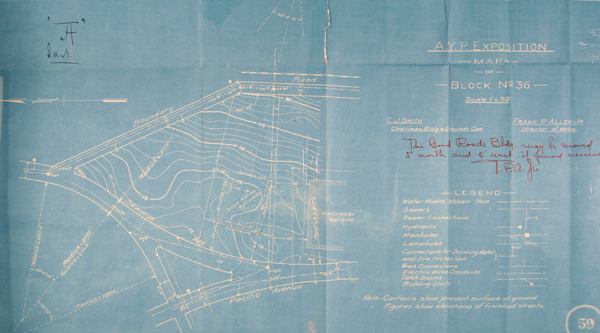Library jewel #2: 1909 A-Y-P Expo Commission collection
Washington has enjoyed its share of world fairs over the years. Simply viewing the iconic Space Needle is a reminder that Seattle hosted the 1962 World’s Fair. And visitors to Spokane’s Riverfront Park can see several buildings and other structures from the ’74 World’s Fair held in the Lilac City.
But not many people know that Washington hosted another international fair more than a century ago. The Alaska-Yukon-Pacific Exposition took place in 1909 on what is now the University of Washington campus in Seattle.
Our second Library jewel is the collection of records and correspondence for the A-Y-P Exposition Commission. The collection contains information about the Forestry Building and Washington Good Roads Building including the records, correspondence, contracts, specifications and geological surveys. Above is a blueprint of the expo’s Good Roads Building.
The State Library provides more details on the commission’s records and the A-Y-P Expo itself:
The Washington State Alaska-Yukon-Pacific Exposition Commission was appointed by Governor Albert E. Mead (1861-1909). Each of the seven commissioners represented a section of the State and operated under an enabling act that directed all state bureaus, departments and commissions to cooperate with the commissioner and the Commission. The Alaska-Yukon-Pacific Exposition, also known as A-Y-P Exposition, opened on the University of Washington campus in Seattle, WA on June 1, 1909. It was originally planned for 1907 to mark the 10th anniversary of the Klondike Gold Rush, but was postponed two years to avoid a conflict with another long exhibition being held in Virginia. The delay gave the planners the opportunity to raise additional funds and expand the scope of the Exposition to encompass all the Pacific Rim countries and territories.
The new scope displayed the value of commercial trade with the Pacific Rim, celebrated a new era of commercial and industrial expansion and promoted Seattle as its center.
The fairgrounds were built on 250 acres of the largely undeveloped campus of the University of Washington. The landscaping of the grounds was designed by the nationally recognized landscape designers, John and Frederick Olmstead and the landscaping left added value to the University.
Most of the buildings were too poorly built to survive because they were made of plaster and razed immediately after the fair. There were two brick buildings that did survive and were used by the University for a number of years.
The Exposition was held June 1, 1909 through October 16, 1909. More than 3 million visitors came from around the state, nation and the world to view hundreds of educational exhibits, stroll the lushly manicured grounds and be entertained on the midway.
Business leaders hoped the Exposition would create an interest in real estate and lure capital for development to Seattle. Though the fair brought money to the city, it didn’t bring very many long term benefits. The anticipated influx of people, the increase of development of Alaska or better trade relations with Pacific rim countries didn’t materialize. The Exposition returned a modest 4% profit and brought a small amount of recognition to Seattle.
